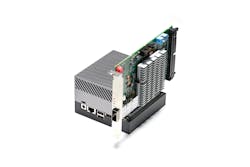Wireless Innovations Powering the Future of Robotics and Industrial Machinery
BitFlow Enhances Frame Grabbers With NVIDIA Jetson for Better Prototyping
BitFlow integrated the NVIDIA Jetson AGX Orin module, which performs 275 trillion operations/s (TOPS) with its CoaXPress (CXP) frame grabbers.
When combined with the NVIDIA AGX Orin Developer Kit, engineers are able to prototype complex machine vision and autonomous inspection applications, using AI image processing while also supporting up to 4 CoaXPress (CXP) cameras and multiple concurrent AI application pipelines.
New applications that augment rule-based machine vision with image-based analysis can be developed more easily, making it possible to move beyond pass/fail to tasks like image classification, image segmentation, and object detection.
Once proof-of-concept is established, a production model can move forward using an Advantech AIR-030 AI Inference System Box featuring PCI Express x16 and based on the NVIDIA Jetson AGX Orin. Time to market and associated development costs are significantly reduced.
BitFlow CXP frame grabbers connect directly to the Jetson AGX Orin via a built-in x16 PCIe slot. Image data can then be transferred at speeds up to 50GB/s from CXP cameras to the NVIDIA Ampere GPU architecture—faster than what NVIDIA Jetson users are typically limited to using USB3 or GigE Vision cameras. BitFlow CXP frame grabbers DMA directly into the embedded GPU memory for image capture, pre-processing, and machine learning inference, shifting the load from the host computer to avoid CPU overhead.
Besides faster transfer speeds, the CoaXPress interface allows a single cable to carry all data, control, triggering, and up to 13 W of power to connected cameras at lengths as far as 328 ft (100 m). CoaXPress eliminates the need for multiple cables and a local power supply, offering more flexibility for prototype designs.
Learn more at www.bitflow.com.
Continuous Autonomous Connectivity for Warehouse Robotics
Rajant Corporation, the pioneer of Kinetic Mesh wireless networks, collaborated with Kinetic Mesh Premier Partner SRSI (Slate River Systems, Inc.) to enable no-gap continuous autonomous connectivity for a customer’s warehouse robotic storage system. SRSI is a material handling systems integrator focused on warehouse solutions and manufacturer of RAFT or Right Angle Fast Transfer—an automated, high-density pallet storage for demanding warehousing and distribution needs.
SRSI found that the client was struggling with the sheer size of their project. Their racks took up a ton of space, making the facility akin to a maze which was causing issues with consistent communication for their robotic equipment. When SRSI tried using the client's Wi-Fi system, it couldn't handle the fast-moving robots and kept causing delays.
Metal racks, heavy equipment, signal interference, and restrained capacity tend to challenge users' wireless networking options. For a warehouse or any indoor industrial operation to deploy a robotic system, SRSI found the right-fit network to overcome the challenges of traditional wireless and improve operational efficiency and reliability with Rajant's Kinetic Mesh, filling the gaps of LTE and Wi-Fi.
After installing the Kinetic Mesh, the client was able to handle shipping and receiving all on its own with a fully automated setup. SRSI placed Rajant's Peregrine BreadCrumbs all around the facility and placed Rajant's ES1's wireless nodes on the robots to ensure they stay connected and receive commands over the air while moving throughout the facility and without having to complete a task and dock before moving on to the next task.
SRSI Network Specialist Gary Wroblewski, “Rajant has allowed us (SRSI) to build a robust and scalable network to support our customers’ success running our advanced RAFT storage system. No other wireless can do what they (Rajant) did.”
“In today’s automated warehouse infrastructure, companies can no longer afford an ineffective communication platform with the amount of Automated Guided Robots (AGRs) flowing throughout the environments,” shares Chris Wall, Rajant Sales Director. “Wi-Fi has limited range, and LTE is cost prohibitive with limited capacity, so companies are turning to Rajant to fix their wireless communications by enabling seamless connectivity throughout the warehouse.”
You can read more in the complete case study at Rajant.com.
CoreTigo's IO-Link Wireless Technology Enhances Natural Stone Processing Machines
World-known manufacturer of natural stone processing plants and machines, Pedrini, and the provider of industrial wireless automation solutions, CoreTigo, have advanced natural stone processing machinery. By integrating CoreTigo's IO-Link Wireless devices into its machinery, Pedrini was able to enhance existing machines without the need to design new machines.
Pedrini’s SPECTRA B220 planetary calibrating machine is designed for thickness grinding of natural stone slabs including marble, granite, and quartzite. The machine’s calibrating unit is composed of numerous spindles equipped with diamond tools. Optimal performance relies on real-time accurate reading and control of the current of each spindle while in high-speed operational mode. The SPECTRA B220 now uses IO-Link Wireless communication for monitoring the machine spindles, replacing the need to run cables from the spindles through the slip rings of the calibrator and to the PLC.
The IO-Link Wireless Bridge (CoreTigo's TigoBridge) is connected to a multiport I/O Hub that communicates current data from 8 spindles at the same time (and a total of 48 spindles/machine with 6 TigoBridges). A single IO-Link Wireless Master (CoreTigo's TigoMaster) collects all the data from the Wireless Bridges on the machine over the air and communicates it directly to the PLC. The data is then visualized on the HMI for real-time machine calibration and optimization.
The use of IO-Link Wireless communication allowed Pedrini to switch from complex and high-cost communication slip rings on the calibrators into smaller and more cost-effective slip rings. This design created a cost-effective solution with reduced deployment time and effort, a simple retrofit and system expansion, and reduced spare parts for slip rings.
Being more reliable than standard Wi-Fi or Bluetooth, IO-Link Wireless can coexist with other wireless networks without requiring line-of-sight and is designed for high-speed motion applications.
About the Author
Laura Davis
Editor-in-Chief, New Equipment Digest
Laura Davis is the editor in chief of New Equipment Digest (NED), a brand part of the Manufacturing Group at EndeavorB2B. NED covers all products, equipment, solutions, and technology related to the broad scope of manufacturing, from mops and buckets to robots and automation. Laura has been a manufacturing product writer for eight years, knowledgeable about the ins and outs of the industry, along with what readers are looking for when wanting to learn about the latest products on the market.

